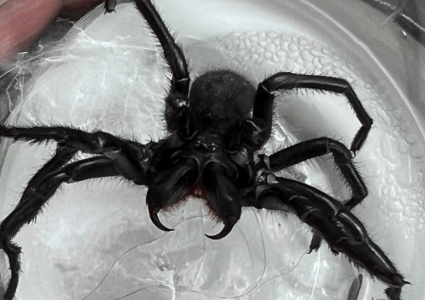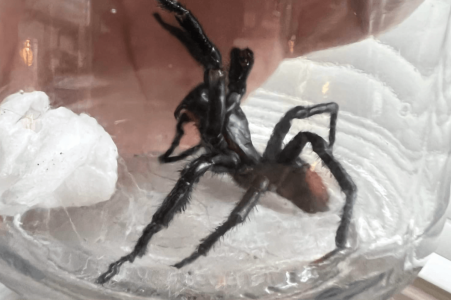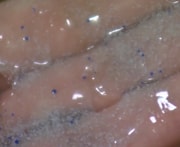Don't kill it! That venomous spider could SAVE lives
- Replies 9
Just imagine, it's a typical evening in the house. You've decided it's finally time to tackle the massive stack of clothing on your bed, and you start folding it.
But then, out of the corner of your eye, you spot movement. You look to where the movement was, and you find a funnel-web spider sitting, looking back at you.
It's natural that most of us would instinctively think, 'must… kill… spider'. However, you may want to think twice.
As it turns out, leaving your eight-legged guest alone could actually save your life – as well as someone else's. Sounds amazing and unbelievable, right?

Ray McGibbon, a snake catcher in New South Wales, told a news source that if you kill a funnel-web spider, you're not only putting yourself and others around you at risk, but you're also decreasing the amount of venom that can be collected.
According to the Australian Museum, up to 30 to 40 people are bitten each year by Sydney funnel-web spiders, with 13 deaths recorded from males of the species.
It's important to be able to tell the difference between a male and a female funnel-web spider since males are the only ones with venom. Identifying the gender of this species of spider can save you a nasty bite and help build up critical vials of venom needed to make the antivenom.
When looking at a funnel-web spider, you should pay close attention to the claws. Males will have three claws which are curved, while females will have two claws that are pointed. In terms of size, males are typically much smaller than females.
Males will be around 25-35mm in body length, while females can range anywhere from 30-50mm in body length.
Another important identifier is the colour of the spiders. While both have a black carapace, males have a brownish colour on their legs and femurs, while females are usually a mottled grey.
It's also a good idea to keep an eye out for the spider's mating habits. During mating season, male funnel-web spiders will be found on trees or buildings looking for females in the surrounding area. This behaviour is known as 'darting' and can lead to the spiders climbing up walls or basement stairs and invading homes.
McGibbon said it takes between 80 and 140 milkings of funnel-web venom to create one vial of antivenom – which is then distributed to hospitals and vets. The invaluable ingredient reportedly costs a huge sum of money to make, around $1000 per vial.
But it's not as easy as that – male funnel-web spiders only live for around 18 months, which makes collecting enough venom for an antivenom vial even more challenging.

So what should you do when you’re minding your business at home when suddenly you spot a venomous spider lurking in the corner?
First things first, don't panic! And before you reach for the nearest shoe or insecticide, experts recommend that the safest and most effective course of action is to keep a watchful eye on the spider from a safe distance and call in the professionals to handle the removal.
And while we don't recommend it, if you want to take matters into your own hands, there are some things you need to keep in mind.
Before you go on your spider-trapping mission, make sure to gear up in protective gear like gardening gloves, long trousers tucked into socks and sturdy shoes or boots. You'll also need to gather some equipment, like a glass jar with a wide mouth, a piece of heavy cardboard or solid plastic, and a moist cotton bud.
Once you're ready, it's time to put your trapping skills to the test.
Invert the jar over the spider, slide the cardboard or plastic under the opening to cover it completely and ensure the spider is secure inside the jar before dropping in a moist cotton ball (to keep them nice, happy, and healthy while inside) and putting on the lid.
Credit: Australian Reptile Park.
But believe us when we say it's not going to be as smooth sailing as you'd like it to be! So it's better to leave the spider-catching to the professionals.
Most bites are actually from someone unqualified attempting to trap or kill spiders.
Around 13 deaths from funnel-web spiders have been recorded between the 1930s and 1980s. Males of this species have been historically known to inject extremely toxic venom into their victims, leading to fatalities in some cases.
Before the development of antivenom in the 1980s, its deadly effects had caused alarm in some areas, with victims experiencing nausea, vomiting, delirium and loss of muscular coordination. In 1982 alone, seven cases of toxic spider bites were reported.
Fortunately, the development of antivenom in the 1980s eventually resulted in a dramatic reduction in the mortality rate, leading to zero recorded deaths since then. It’s estimated that around 30 to 40 people are bitten by funnel-web spiders each year.
It goes to show that funnel-web spiders are not something to be taken lightly. If you have any suspicion of an infestation, do not hesitate to contact a certified snake catcher for professional help.
Pros can catch the eight-legged critter and safely transport them to Australian Reptile Park drop-off points, where they can be used to save lives through the park's funnel-web spider venom program.

A funnel-web spider bite is a serious matter, and immediate action is crucial.
If you suspect you or someone you know has been bitten, it's important to remain as calm as possible and apply pressure and an immobilisation bandage to the affected area.
Then, contact emergency services and seek medical attention at the hospital as soon as possible.
It's also important to stay informed and up-to-date on the latest venomous first aid guidance, so be sure to visit the NSW Poisons Information Centre and Australian Bites and Stings websites for more information.
Credit: ABC Science.
We hope this guide will be useful for you if you ever come across a funnel-web spider in your home. For your safety, we ask that you proceed with caution and make sure not to approach or provoke the spider in any way.
Stay safe always, everyone!
But then, out of the corner of your eye, you spot movement. You look to where the movement was, and you find a funnel-web spider sitting, looking back at you.
It's natural that most of us would instinctively think, 'must… kill… spider'. However, you may want to think twice.
As it turns out, leaving your eight-legged guest alone could actually save your life – as well as someone else's. Sounds amazing and unbelievable, right?

If you happen to find a funnel-web spider in your home, don't reach for a shoe or insecticide! Credit: Facebook/Southern highlands snake catcher.
Ray McGibbon, a snake catcher in New South Wales, told a news source that if you kill a funnel-web spider, you're not only putting yourself and others around you at risk, but you're also decreasing the amount of venom that can be collected.
According to the Australian Museum, up to 30 to 40 people are bitten each year by Sydney funnel-web spiders, with 13 deaths recorded from males of the species.
It's important to be able to tell the difference between a male and a female funnel-web spider since males are the only ones with venom. Identifying the gender of this species of spider can save you a nasty bite and help build up critical vials of venom needed to make the antivenom.
When looking at a funnel-web spider, you should pay close attention to the claws. Males will have three claws which are curved, while females will have two claws that are pointed. In terms of size, males are typically much smaller than females.
Males will be around 25-35mm in body length, while females can range anywhere from 30-50mm in body length.
Another important identifier is the colour of the spiders. While both have a black carapace, males have a brownish colour on their legs and femurs, while females are usually a mottled grey.
It's also a good idea to keep an eye out for the spider's mating habits. During mating season, male funnel-web spiders will be found on trees or buildings looking for females in the surrounding area. This behaviour is known as 'darting' and can lead to the spiders climbing up walls or basement stairs and invading homes.
McGibbon said it takes between 80 and 140 milkings of funnel-web venom to create one vial of antivenom – which is then distributed to hospitals and vets. The invaluable ingredient reportedly costs a huge sum of money to make, around $1000 per vial.
But it's not as easy as that – male funnel-web spiders only live for around 18 months, which makes collecting enough venom for an antivenom vial even more challenging.

These spiders are said to 'thrive' in humid weather. Credit: Facebook/Southern highlands snake catcher.
So what should you do when you’re minding your business at home when suddenly you spot a venomous spider lurking in the corner?
First things first, don't panic! And before you reach for the nearest shoe or insecticide, experts recommend that the safest and most effective course of action is to keep a watchful eye on the spider from a safe distance and call in the professionals to handle the removal.
And while we don't recommend it, if you want to take matters into your own hands, there are some things you need to keep in mind.
Before you go on your spider-trapping mission, make sure to gear up in protective gear like gardening gloves, long trousers tucked into socks and sturdy shoes or boots. You'll also need to gather some equipment, like a glass jar with a wide mouth, a piece of heavy cardboard or solid plastic, and a moist cotton bud.
Once you're ready, it's time to put your trapping skills to the test.
Invert the jar over the spider, slide the cardboard or plastic under the opening to cover it completely and ensure the spider is secure inside the jar before dropping in a moist cotton ball (to keep them nice, happy, and healthy while inside) and putting on the lid.
Credit: Australian Reptile Park.
But believe us when we say it's not going to be as smooth sailing as you'd like it to be! So it's better to leave the spider-catching to the professionals.
Most bites are actually from someone unqualified attempting to trap or kill spiders.
Around 13 deaths from funnel-web spiders have been recorded between the 1930s and 1980s. Males of this species have been historically known to inject extremely toxic venom into their victims, leading to fatalities in some cases.
Before the development of antivenom in the 1980s, its deadly effects had caused alarm in some areas, with victims experiencing nausea, vomiting, delirium and loss of muscular coordination. In 1982 alone, seven cases of toxic spider bites were reported.
Fortunately, the development of antivenom in the 1980s eventually resulted in a dramatic reduction in the mortality rate, leading to zero recorded deaths since then. It’s estimated that around 30 to 40 people are bitten by funnel-web spiders each year.
It goes to show that funnel-web spiders are not something to be taken lightly. If you have any suspicion of an infestation, do not hesitate to contact a certified snake catcher for professional help.
Pros can catch the eight-legged critter and safely transport them to Australian Reptile Park drop-off points, where they can be used to save lives through the park's funnel-web spider venom program.
Key Takeaways
- Be careful not to kill any funnel-web spiders you see in your home, as they might prove useful in developing antivenom vials, potentially saving lives.
- Instead, it's best to call in professionals to safely transport these critters to conservation parks where they can be studied and protected.
If you suspect you or someone you know has been bitten, it's important to remain as calm as possible and apply pressure and an immobilisation bandage to the affected area.
Then, contact emergency services and seek medical attention at the hospital as soon as possible.
It's also important to stay informed and up-to-date on the latest venomous first aid guidance, so be sure to visit the NSW Poisons Information Centre and Australian Bites and Stings websites for more information.
Credit: ABC Science.
We hope this guide will be useful for you if you ever come across a funnel-web spider in your home. For your safety, we ask that you proceed with caution and make sure not to approach or provoke the spider in any way.
Stay safe always, everyone!







